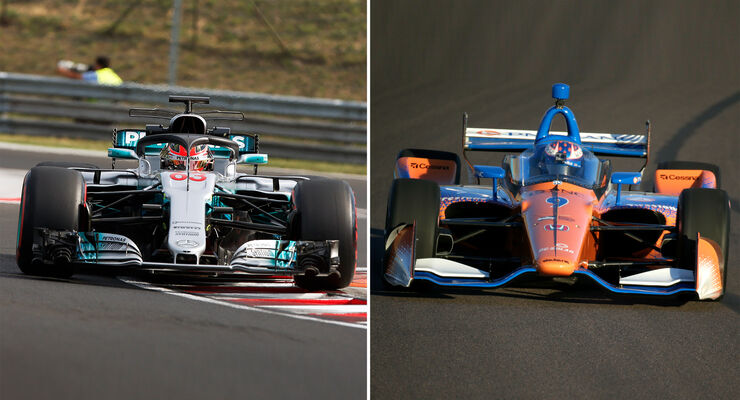Indy's solution should humble the F1 enough to made the redo the damned thing for 2019 or scrap it all together.
- Login or Register
No account yet? Sign up
Just_a_fan wrote: ↑06 Feb 2018, 12:27
...Optics are another issue. The aircraft screen doesn't give perfect optical performance but it doesn't need to. The driver in the car is seeing very fast moving scenery that crosses his vision on both sides and across the front. He needs good vision to place the car. The pilot, although able to travel many times faster than the car, isn't exposed to the same movement of objects in his field of view. Minor distortion, whilst undesirable, can be accepted because the pilot doesn't need to place his plane to the inch in the way the driver does. Even landing on an aircraft carrier is accurate only within several feet and, once close to the fantail, there is no need to see perfect detail anyway as you can't do anything about it.
Clever shaping of the screen could deal with some of the distortion but only so long as the eyes remain in the same place. Add in head movement and vibration and it becomes very difficult.
Having looked through several aircraft canopies (civilian and military) over the years, I can tell you they are not perfectly distortion free.
4 dimensions???- in all 4 dimensions -
The key phrase there is "properly functional". Optical and structural issues have to be dealt with to make them functional in a safe and effective manner. We know optics are a problem because Vettel told us it was. We know there is a structural issue because the FIA tests found the screen didn't work properly. Sort those issues out and bring the solution to the table and the screen can then be considered.None of your apparent objections stand as preventing the adoption of a properly functional aero-screen in Indy Car, or F1..
Has the Indy screen been shown to keep a flying wheel away from the driver's head? It looks thin and incapable of withstanding such an impact.
Until/unless Indycar release some footage/data of their testing we don't know that for sure. What I am sure of from the geometry is that the driver's head is more exposed to debris coming from an angle (can't find the picture of the driver in the simulator with it). The FIA wanted the halo to protect from intrusion up to 15degrees from the longitudinal axis, which is why it remains higher further around the sides to the top rather than the front of the cockpit surround. The kinetic energy aerospace polycarbonate has to withstand for bird strike (having looked into it 4lb at 350knots ~630km/hr) and a for a racing wheel (11kg at 240km/hr) is similar 25-30kJ so I can't imagine the material will have any issue withstanding the impact - as was the case with the proper aerospace canopy in the FIA tests. Not sure what their 1/2 canopy was made of.Just_a_fan wrote: ↑07 Feb 2018, 11:13Has the Indy screen been shown to keep a flying wheel away from the driver's head? It looks thin and incapable of withstanding such an impact.

It's noticeably a huge amount thicker than the windscreen the FiA tested. Looks great tho!Santozini wrote: ↑09 Feb 2018, 10:29Dixon cautiously positive after first IndyCar aeroscreen run:
https://www.motorsport.com/indycar/news ... n-1003353/
I like it!

It's never been an issue for SportsCars so I doubt it'd be an issue for the Indycar's fitted with the screen - just coat it in RainX or something similar.Just_a_fan wrote: ↑09 Feb 2018, 11:44Dixon did say they need to try it on a road course to see if/how looking in to real corners was affected. The ovals don't have the direction change and associated need to look laterally through the arc of the screen.
It certainly looks good so far.
I wonder what it'll be like in the rain. Also, in the rain under artificial lights. Something the Indy guys don't need to worry about on ovals, of course.
This screen is considerably thicker with a much tighter curvature than in any other circuit racing series!! Sports car's also have wipers!?!

Fighters use a HUD for targeting, and HUD has software correction for the distortion.J.A.W. wrote: ↑07 Feb 2018, 11:54Any Western fighter aircraft of the past 75 years - with a pilot's view showing an optical distortion level such as Ferrari tested,
would quite plainly, never pass service-acceptance trials..
& yes, 4 dimensions in fighter aircraft, roll, pitch, yaw, & vector-velocity ('space-time').



One is developed over years with crash tests and science, data from previous crashes and all those kinds of things and the other one we don’t know anything about apart from a single road test and a few pictures.mclaren111 wrote: ↑09 Feb 2018, 16:111000% better than the the Halo.
Why is it that Indycar does so many things better than the FIA ??
Just look at the difference

https://imgr3.auto-motor-und-sport.de/I ... 146081.jpg